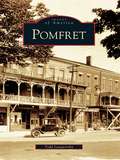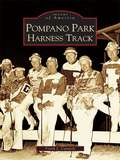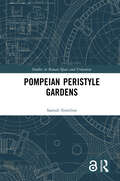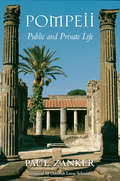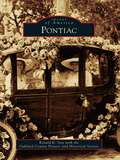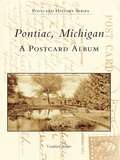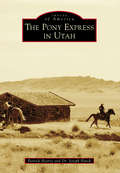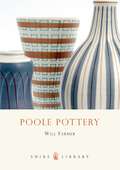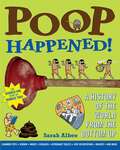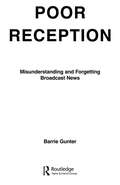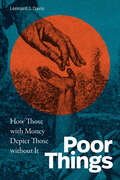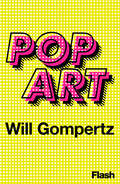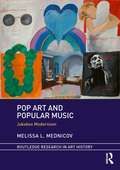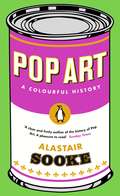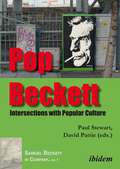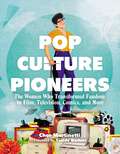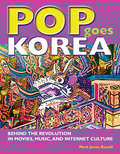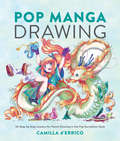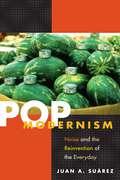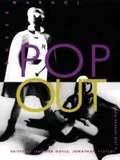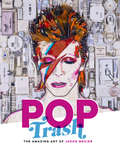- Table View
- List View
Pomfret (Images of America)
by Todd LangworthyWhen shipbuilder Zattu Cushing passed through western New York State at the beginning of the 19th century, he saw a beautiful area that had great potential for settlement. He vowed to come back and settle with his family as soon as possible. In 1805, Cushing came back and became the first permanent settler in what was to become the town of Pomfret. Pomfret quickly grew, attracting people of great talent to the small settlement situated on Canadaway Creek near Lake Erie. Soon the village of Fredonia was chartered within the town, leading to even more fantastic growth. Pomfret became a town of many firsts, as well as the home of countless noteworthy families. Today Pomfret is a vibrant community that is proud of its past and excited about its future.
Pompano Beach
by Frank J. CavaioliLocated on Florida's Atlantic Coast midway between Palm Beach and Miami, Pompano Beach marks the northern boundary of the Florida reef at the outlet from the Intracoastal Waterway to the ocean. Incorporated in 1908, the city is now home to more than 82,000 residents, who consider their community, with its historic buildings, pristine beaches, and comfortable lifestyle, the "Gem of the Gold Coast."The completion of the Pompano Canal in 1890 and the arrival of the Flagler Florida East Coast Railway in 1896 provided the basis for the early development around Lettuce Lake, now Lake Santa Barbara, and Pompano Beach's rich farmland attracted the area's first settlers. These stalwart men and women faced with determination the challenges of natural disasters and economic uncertainty and carved their prosperous community out of the harsh Florida landscape. Prominent people, such as the McNab brothers, George L. Blount, the Garner family, George and Mary Butler, Blanche Ely, the Rolle family, and others, took part in the developing tale of Pompano Beach, while local landmarks and events, such as the Kester Cottages, the State Farmers' Market, Pompano Harness Park, Goodyear Blimp, the Holiday Boat Parade, the Broward County Fair, and Pioneer Days, helped to shape the area's rich heritage. Featuring over 200 vintage photographs of such people and places, this pictorial retrospective captures, in word and image, the scenes of Pompano Beach's unique history.
Pompano Park Harness Track
by Frank J. CavaioliKnown as the "Winter Capital of Harness Racing," Pompano Park has provided the only nighttime standardbred harness competition in Florida since its 1964 inaugural season. Prominent Kentucky horseman Frederick Van Lennep and his wife, Frances Dodge Van Lennep, built a $5.5-million track on the property of a failed 1926 thoroughbred track in Pompano Beach. Pompano Park has since hosted leading trainers, drivers, and champion horses, including Hall of Famers Stanley Dancer, Bill Haughton, and Delvin Miller and current leading drivers Bruce Ranger and Wally Hennessey. It also has been a mecca for celebrities who have enjoyed the racing action and entertainment.
Pompeian Peristyle Gardens (Studies in Roman Space and Urbanism)
by Samuli SimeliusThis book examines how Pompeian peristyle gardens were utilized to represent the socioeconomic status of Roman homeowners, introducing fresh perspectives on how these spaces were designed, used, and perceived. Pompeian Peristyle Gardens provides a novel understanding of how the domus was planned, utilized, and experienced through a critical examination of all Pompeian peristyles – not just by selecting a few well-known examples. This study critiques common scholarly assumptions of ancient domestic space, such as the top-down movement of ideas and the relationship between wealth and socio-political power, though these possibilities are not excluded. In addition, this book provides a welcome contribution to exploring the largely unexamined middle class, an integral part of ancient Roman society. Pompeian Peristyle Gardens is of interest to students and scholars in art history, classics, archaeology, social history, and other related fields.
Pompeii: Public and Private Life (Revealing antiquity ; #Vol. 11)
by Paul ZankerPompeii’s tragedy is our windfall: an ancient city fully preserved, its urban design and domestic styles speaking across the ages. This richly illustrated book conducts us through the captured wonders of Pompeii, evoking at every turn the life of the city as it was 2,000 years ago. When Vesuvius erupted in 79 A.D. its lava preserved not only the Pompeii of that time but a palimpsest of the city’s history, visible traces of the different societies of Pompeii’s past. Paul Zanker, a noted authority on Roman art and architecture, disentangles these tantalizing traces to show us the urban images that marked Pompeii’s development from country town to Roman imperial city. Exploring Pompeii’s public buildings, its streets and gathering places, we witness the impact of religious changes, the renovation of theaters and expansion of athletic facilities, and the influence of elite families on the city’s appearance. Through these stages, Zanker adeptly conjures a sense of the political and social meanings in urban planning and public architecture. The private houses of Pompeii prove equally eloquent, their layout, decor, and architectural detail speaking volumes about the life, taste, and desires of their owners. At home or in public, at work or at ease, these Pompeians and their world come alive in Zanker’s masterly rendering. A provocative and original reading of material culture, his work is an incomparable introduction to urban life in antiquity.
Pontiac
by Oakland County Pioneer & Historical Society Ronald K. GayDetroit's first mayor, Solomon Sibley, and his wife, Sarah (Sproat) Sibley, were responsible for organizing a group that set out in 1818 for a plot of land 30 miles north, at the confluence of the Huron River of St. Clair (now the Clinton) and several Native American trails. The future town would be named for Pontiac, the warrior chief of the Ottawa Nation, best known for his "Indian uprising" of 1763 against the British at Fort Detroit and Fort Michilimackinac. Many of Pontiac's founding fathers were veterans of the War of 1812. They named their new streets for heroic figures of those struggles: Lawrence, Perry, and Clinton. Two years after settlement, Pontiac became the county seat for Oakland. It would also become a mill town, railroad hub, wagon and buggy manufacturing center, the site of a state asylum, and a mecca for automotive industries. Pontiac was the nation's leading manufacturer of trucks and buses, before and during the heyday of General Motors Truck and Coach division. The construction of the Pontiac Airport in 1928 only enhanced the city's role in southeast Michigan. It has long been a cultural melting pot. Today Pontiac is known as the northern Woodward Avenue terminus for the annual "Dream Cruise."
Pontiac, Michigan: A Postcard Album (Postcard History)
by Gottfried BriegerI am sending you this so you won't forget Pontiac. This is the sentiment inscribed on one of the postcards included in this collection. Pontiac, Michigan: A Postcard Album brings to life the history of this uniquely American city. The postcard has always been a very popular means of communication, and now as a historical document, it offers us a fascinating insight into the times and places of the past. Like many cities, Pontiac has passed through many phases, from agricultural center to auto manufacturer--through good times and bad. These postcards capture the people and places of Pontiac, and remind us of the courageous people who built this country.
Pony Express in Utah, The
by Patrick Hearty Dr Joseph HatchThe Pony Express stands out in the history of the American West, memorable and captivating for the romance and adventure it evokes. The image of the intrepid young rider on a fast horse, crossing mountain and desert with his precious cargo of mail, is known and loved around the world as an icon of the Western frontier. Although its service was short, only about 19 months, its mystique seems to continue to grow after more than 150 years. Utah and the Pony Express were vital to each other. Salt Lake City was the major center of population between the Missouri River and the West Coast. Utah-bred men managed the line, rode the Express horses, and kept vigil at the lonely desert stations. This book tells the stories of those men and those stations, as well as advancements in communication and the celebrations that have kept the memory of the Pony Express in Utah alive.
Poole Pottery
by Johnny Shumate Will FarmerPoole Pottery is recognized as one of the most distinctive and most collected potteries of the twentieth century. Founded by Jesse Carter in 1873, by the 1880s the factory was well known for its tiling products, mosaic flooring and advertising panels. After the turn of the century the company flourished in the hands of the founder's sons, developing the hand-decorated style that would be their signature for many years to come.In 1921, Charles Carter, the respected designer Harold Stabler, and the husband and wife John and Truda Adams established a subsidiary that would establish Poole as one of the centres of ceramic arts. The firm began to draw inspiration from many historical styles and cultures including Egyptian, Grecian and the Middle East all combined with the revival of the Delftware technique of freehand painting on a white tin glazed ground. Throughout the 1920s and '30s Poole became synonymous with elegant and expertly executed wares produced in a daring and highly decorative style of modernism. The firm grew rapidly and employed a number of key artists and decorators who in turn brought their own ideas to the table.Post-war production was mostly based on pre-war designs, but in 1958 the company developed a whole new range of 'studio ware'. The Studio was seen as a design hot bed, with nothing off limits and no treatments or techniques out of bounds. The pieces from this period were expensive to produce, but the level of production and quality of design put Poole firmly at the front of the British craft pottery movement. This range became the basis for the more commercial Delphis range, which found immediate success and helped the company maintain its market position.The end of the twentieth century was a more difficult time for Poole, but it remains one of the great names of British ceramics and the decorative arts. In this highly illustrated introduction Poole devotee and expert Will Farmer tells the story of this remarkable and popular firm.From the Trade Paperback edition.
Poop Happened!: A History Of The World From The Bottom Up
by Sarah Albee Robert LeightonDid lead pipes cause the fall of the Roman Empire? How many toilets were in the average Egyptian pyramid? How did a knight wearing fifty pounds of armor go to the bathroom? Was poor hygiene the last straw before the French Revolution? Did Thomas Crapper really invent the modern toilet? How do astronauts go in space? History finally comes out of the water-closet in this exploration of how people's need to relieve themselves shaped human development from ancient times to the present. Throughout time, the most successful civilizations were the ones who realized that everyone poops, and they had better figure out how to get rid of it! From the world's first flushing toilet invented by ancient Minoan plumbers to castle moats in the middle ages that used more than just water to repel enemies, Sarah Albee traces human civilization using one revolting yet fascinating theme. A blend of historical photos and humorous illustrations bring the answers to these questions and more to life, plus extra-gross sidebar information adds to the potty humor. This is bathroom reading kids, teachers, librarians, and parents won't be able to put down!
Poor Reception: Misunderstanding and Forgetting Broadcast News (Routledge Communication Series)
by Barrie GunterPublished in 1990, Poor Reception is a valuable contribution to the field of Communication Studies.
Poor Things: How Those with Money Depict Those without It
by Lennard J. DavisFor generations most of the canonical works that detail the lives of poor people have been created by rich or middle-class writers like Charles Dickens, John Steinbeck, or James Agee. This has resulted in overwhelming depictions of poor people as living abject, violent lives in filthy and degrading conditions. In Poor Things, Lennard J. Davis labels this genre “poornography”: distorted narratives of poverty written by and for the middle and upper classes. Davis shows how poornography creates harmful and dangerous stereotypes that build barriers to social justice and change. To remedy this, Davis argues, poor people should write realistic depictions of themselves, but because of representational inequality they cannot. Given the obstacles to the poor accessing the means of publication, Davis suggests that the work should, at least for now, be done by “transclass” writers who were once poor and who can accurately represent poverty without relying on stereotypes and clichés. Only then can the lived experience of poverty be more fully realized.
Pop Art
by Will GompertzUn Gompertz muy Gompertz. Un texto sobre los precursores del Pop Art y las revolucionarias ideas que dieron pie al movimiento. En este texto, incluido en el exitoso libro ¿Qué estás mirando? 150 años de arte moderno en un abrir y cerrar de ojos, el autor desgrana las obras que marcaron el inicio y posteriormente la consagración del Pop Art, así como la trayectoria de sus autores. Gompertz nos sitúa en diferentes puntos estratégicos del mapa mundial para trazar las vidas de los precursores del movimiento: Paolozzi, Jasper Jones, Robert Rauschenberg, Warhol, Lichtenstein o Richard Hamilton —por mencionar algunos—; y relata con una prosa absorbente el minuto exacto en el que dieron a luz a sus obras más emblemáticas. Esta corriente artística, considerada por algunos como arte «fácil» para una masa pueril, en el fondo no defendía otra cosa que la democratización de la cultura y reivindicaba que no existía un arte elevado, sino que había valor en las imágenes que formaban parte del mundo cotidiano (aunque estas fueran el resultado impersonal de la producción en cadena). Así, una botella de Coca-Cola se elevaba al nivel de una escultura de Bernini. Siguiendo esta tesis, los artistas del Pop Art descontextualizaron los objetos de la sociedad de consumo para romper mediante la ironía y el color con la corriente artística imperante: el expresionismo abstracto. Con un estilo narrativo propio de la literatura, el autor constata su maestría como uno de los mayores expertos en arte moderno y contagia su entusiasmo a lo largo de estas páginas. Una pieza clave para entender que el Pop Art siempre ha estado entre nosotros, pero necesitábamos a los artistas para descubrirlo. «Gompertz ha escrito un enérgico y completo recorrido por el arte moderno».The Independent Sobre el autor se dijo:«A Gompertz lo de aburrir no se le da nada bien».The Times «Will Gompertz es el mejor profesor que haya tenido jamás».The Guardian «Gompertz ha escrito un enérgico y completo recorrido por el arte moderno».The Independent «Will Gompertz un tipo singular. Rápido como la sangre. Y de algún modo un defensor de la claridad en un territorio de opacidades. Entra en faena desde un libro lúcido que tiene algo de síntesis mental de lo complejo. Una exploración que desacraliza con audacia e ironía tanto el cuello duro de la crítica de arte, a la vez que hace su propia crítica desde la orilla de la claridad».Antonio Lucas, El Mundo «Es tan provocador, irreverente, irónico, divertido y políticamente incorrecto como muchos de los artistas de los que habla. Gompertz da un buen repaso (en todos los sentidos) al arte moderno y contemporáneo. Su visión del mundo del arte es inteligente, salpimentada con buenas dosis de humor».Nati Pulido, ABC «Tanta contundencia en las opiniones proviene de Will Gompertz, director de arte de la BBC y considerado una autoridad mundial en el arte moderno y contemporáneo. [...] En realidad, el libro requiere algo más que un simple pestañeo. Se lee más bien como un completo y ameno manual de 472 páginas».Ángeles García, El País «Para salvar la brecha que separa a muchos visitantes de los objetos que contemplan, Gompertz ha escrito precisamente ¿Qué estás mirando?, un ameno recorrido por la creación moderna para que la comprenda todo el mundo».Javier Ors, La Razón
Pop Art and Popular Music: Jukebox Modernism (Routledge Research in Art History)
by Melissa L. MednicovThis book offers an innovative and interdisciplinary approach to Pop art scholarship through a recuperation of popular music into art historical understandings of the movement. Jukebox modernism is a procedure by which Pop artists used popular music within their works to disrupt decorous modernism during the sixties. Artists, including Peter Blake, Pauline Boty, James Rosenquist, and Andy Warhol, respond to popular music for reasons such as its emotional connectivity, issues of fandom and identity, and the pleasures and problems of looking and listening to an artwork. When we both look at and listen to Pop art, essential aspects of Pop’s history that have been neglected—its sounds, its women, its queerness, and its black subjects—come into focus.
Pop Art: A Colourful History
by Alastair SookePop Art by the BBC's Alastair Sooke - an essential but snappy new guide to our favourite art movementPop Art is the most important 20th-century art movement. It brought Modernism to the masses, making art sexy and fun with coke cans and comics. Today, in our age of selfies and social networking, we are still living in a world defined by Pop.Full of brand new interviews and research, Sooke describes the great works by Warhol, Lichtenstein and other key figures, but also re-examines the movement for the 21st century and asks if it is still art? He reveals a global story, tracing Pop's surprising origins in 19th-century Paris to uncovering the forgotten female artists of the 1960s."A clear and lively outline of the history of pop art ... a pleasure to read" - Sunday Times
Pop Beckett: Intersections with Popular Culture (Samuel Beckett in Company #6)
by Paul StewartWhen Samuel Beckett’s work first appeared, it was routinely described, by Adorno among others, as a clear example of European high culture. However, this judgement ignored an aspect of Beckett’s work and its reception that is, arguably, not yet fully understood; the intimate relation between his work and popular culture. Beckett used popular cultural forms; but popular culture has also found a place both for the work and for the man. This collection of essays examines how popular cultural forms and media are woven into the fabric of Beckett’s works and how Beckett continues to have far-reaching impact on popular culture today in a host of different forms, in film and on television, from comics to meme culture, tourism to marketing.
Pop Culture Pioneers: The Women Who Transformed Fandom in Film, Television, Comics, and More
by Cher MartinettiCelebrate the empowering and inspiring women who helped create, shape, and make pop culture great, from the creator of SYFY WIRE's FANGRRLS and the podcast "Forgotten Women of Genre"! In every medium in popular culture—from books, films, and video games to comics, television, and animation—women have been instrumental in creating and shaping the worlds, characters, and genres that we know and love. However, much of their hard work and innovation has gone largely unrecognized—until now. With a foreword by American Gods actress Yetide Badaki and essays exploring the history and transformation of pop culture's genres and mediums, Pop Culture Pioneers explores and pays respect to the women who played a crucial role in creating and influencing of some of the most famous worlds and characters in pop culture including:Directors & Producers like Karyn Kusama (Aeon Flux, Jennifer's Body), Denise Di Novi (co-producer of Batman Returns, The Nightmare Before Christmas), and Jean MacCurdy (producer of Batman: The Animated Series, Animaniacs)Writers & Editors like Jeanette Khan (editor and publisher of DC Comics), Alice Bradley Sheldon (writing as James Tiptree Jr.), and Alison Bechdel (Fun Home)Animators & Artists like Rebecca Sugar (Steven Universe), Noelle Stevenson (She-Ra and the Princesses of Power) and Brenda Chapman (animator and director of Brave)As well as Marlene Clark (Blaxploitation actress), Roberta Williams (creator of the adventure game genre), Yvonne Blake (costume designer for Superman), Bonnie Erickson (co-creator of Miss Piggy), and many more.
Pop Goes Korea: Behind the Revolution in Movies, Music, and Internet Culture
by Mark James RussellFrom kim chee to kim chic! South Korea came from nowhere in the 1990s to become one of the biggest producers of pop content (movies, music, comic books, TV dramas, online gaming) in Asia--and the West.<P><P> Why? Who's behind it? Mark James Russell tells an exciting tale of rapid growth and wild success marked by an uncanny knack for moving just one step ahead of changing technologies (such as music downloads and Internet comics) that have created new consumer markets around the world. Among the media pioneers profiled in this book is film director Kang Je-gyu, maker of Korea's first blockbuster film Shiri; Lee Su-man, who went from folk singer to computer programmer to creator of Korea's biggest music label; and Nelson Shin, who rose from North Korea to the top of the animation business. Full of fresh analysis, engaging reportage, and insightful insider anecdotes, Pop Goes Korea explores the hallyu (the Korean Wave) hitting the world's shores in the new century.Mark James Russell has been living in Korea since 1996. His articles about Korean and Asian cultures have appeared in Newsweek, The New York Times, International Herald-Tribune, and many other publications. He is currently the Korea/Japan Bureau Chief for Asian Movie Week magazine.
Pop Manga Drawing: 30 Step-by-Step Lessons for Pencil Drawing in the Pop Surrealism Style
by Camilla d'ErricoAn easy-to-follow, step-by-step manga drawing instruction book from fan favorite manga artist and painter Camilla d'Errico, featuring 30 lessons on illustrating cute, cool, and quirky characters in the Pop Surrealist style with pencils.With wildly popular appearances at Comic Cons and her paintings displayed in art galleries around the world, Camilla d'Errico has established herself as a go-to resource for manga-influenced art. Following in the footsteps of her past art instruction books Pop Manga and Pop Painting, Pop Manga Drawing provides the most direct and accessible lessons yet for rendering characters in her signature Pop Surrealist style. Written in the fun and encouraging voice that fans have come to expect, Pop Manga Drawing takes you step-by-step through lessons on drawing with graphite and mechanical pencils, along with insights on enhancing pieces with other mediums (including acrylics, markers, and colored pencils). It also provides tips and expert advice on drawing specific elements, including hair, eyes, and animals, that can take your manga art to the next level. Pop Manga Drawing grants one-of-a-kind access to the basic building blocks of artistic expression, giving you the tools you need to create your own pop manga masterpieces.
Pop Manga: How to Draw the Coolest, Cutest Characters, Animals, Mascots, and More
by Stephen W. Martin Camilla D'ErricoRenowned manga artist and comics creator Camilla D'Errico's beginner's guide to drawing her signature Japanese-style characters.From comics to video games to contemporary fine art, the beautiful, wide-eyed-girl look of shoujo manga has infiltrated pop culture, and no artist's work today better exemplifies this trend than Camilla D'Errico's. In her first instructional guide, D'Errico reveals techniques for creating her emotive yet playful manga characters, with lessons on drawing basic body construction, capturing action, and creating animals, chibis, and mascots. Plus, she gives readers a behind-the-scenes look at her character design process, pointers on creating their own comics, and prompts for finishing her drawings. Pop Manga is both a celebration of creativity and an indespensible guide that is sure to appeal to manga diehards and aspiring artists alike.
Pop Modernism: Noise and the Reinvention of the Everyday
by Juan A. SuárezPop Modernism examines the popular roots of modernism in the United States. Drawing on a wide range of materials, including experimental movies, pop songs, photographs, and well-known poems and paintings, Juan A. Suárez reveals that experimental art in the early twentieth century was centrally concerned with the reinvention of everyday life. Suárez demonstrates how modernist writers and artists reworked pop images and sounds, old-fashioned and factory-made objects, city spaces, and the languages and styles of queer and ethnic “others.” Along the way, he reinterprets many of modernism’s major figures and argues for the centrality of relatively marginal ones, such as Vachel Lindsay, Charles Henri Ford, Helen Levitt, and James Agee. As Suárez shows, what’s at stake is not just an antiquarian impulse to rescue forgotten past moments and works, but a desire to establish an archaeology of our present art, culture, and activism.
Pop Out: Queer Warhol
by Jennifer Doyle José Esteban Muñoz Jonathan FlatleyAndy Warhol was queer in more ways than one. A fabulous queen, a fan of prurience and pornography, a great admirer of the male body, he was well known as such to the gay audiences who enjoyed his films, the police who censored them, the gallery owners who refused to show his male nudes, and the artists who shied from his swishiness, not to mention all the characters who populated the Factory. Yet even though Warhol became the star of postmodernism, avant-garde, and pop culture, this collection of essays is the first to explore, analyze, appreciate, and celebrate the role of Warhol's queerness in the making and reception of his film and art. Ranging widely in approach and discipline, Pop Out demonstrates that to ignore Warhol's queerness is to miss what is most valuable, interesting, sexy, and political about his life and work.Written from the perspectives of art history, critical race theory, psychoanalysis, feminist theory, cinema studies, and social and literary theory, these essays consider Warhol in various contexts and within the history of the communities in which he figured. The homoerotic subjects, gay audiences, and queer contexts that fuel a certain fascination with Warhol are discussed, as well as Batman, Basquiat, and Valerie Solanas. Taken together, the essays in this collection depict Warhol's career as a practical social reflection on a wide range of institutions and discourses, including those, from the art world to mass culture, that have almost succeeded in sanitizing his work and his image.Contributors. Jennifer Doyle, Jonathan Flatley, Marcie Frank, David E. James, Mandy Merck, Michael Moon, José Esteban Muñoz, Eve Kosofsky Sedgwick, Brian Selsky, Sasha Torres, Simon Watney, Thomas Waugh
Pop Painting
by Camilla D'ErricoA unique behind-the-scenes guide to the painting process of one of the most popular artists working in the growing, underground art scene of Pop Surrealism.Painting superstar Camilla d'Errico opens up her studio and offers readers an insider scoop on the tools, techniques, and inspirations she draws from to create stunningly beautiful, otherworldly works of art. Pop Surrealism, with its unique blend of high art and popular culture, has been a growing force in the art world for years. Artists working in Pop Surrealism use elements of manga, cartoons, movies, and more to produce paintings that have been displayed in galleries and purchased by collectors around the globe. In addition to her work in manga and as the author of the best-selling Pop Manga, d'Errico is also one of the Pop Surrealism movement's biggest names. From high-end art galleries to comic book conventions, d'Errico's works draw legions of fans, collectors, and admirers. With Pop Painting, fans and aspiring painters get an up-close look at the step-by-step processes she employs to transform oil and acrylic paints into unforgettable images of her ethereal and beautiful characters. This one-of-a-kind look at a painter at the top of her field reveals all the materials and methods readers need to join the ranks of the Pop Surrealism movement.From the Trade Paperback edition.
Pop Song: Adventures in Art & Intimacy
by Larissa Pham"A fresh, energetic voice with a brilliant mind to power it," brings readers an endlessly inventive, intimate, and provocative memoir-in-essays that celebrates the strange and exquisite state of falling in love--whether with a painting or a person--and interweaves incisive commentary on modern life, feminism, art and sex with the author's own experiences of obsession, heartbreak, and past trauma (Esmé Weijun Wang, New York Times bestselling author of The Collected Schizophrenias).Like a song that feels written just for you, Larissa Pham's debut work of nonfiction captures the imagination and refuses to let go. Pop Song is a book about love and about falling in love--with a place, or a painting, or a person--and the joy and terror inherent in the experience of that love. Plumbing the well of culture for clues and patterns about love and loss--from Agnes Martin's abstract paintings to James Turrell's transcendent light works, and Anne Carson's Eros the Bittersweet to Frank Ocean's Blonde--Pham writes of her youthful attempts to find meaning in travel, sex, drugs, and art, before sensing that she might need to turn her gaze upon herself. Pop Song is also a book about distances, near and far. As she travels from Taos, New Mexico, to Shanghai, China and beyond, Pham meditates on the miles we are willing to cover to get away from ourselves, or those who hurt us, and the impossible gaps that can exist between two people sharing a bed. Pop Song is a book about all the routes by which we might escape our own needs before finally finding a way home. There is heartache in these pages, but Pham's electric ways of seeing create a perfectly fractured portrait of modern intimacy that is triumphant in both its vulnerability and restlessness.
Pop Trash
by Jason MercierArtist Jason Mecier creates insanely detailed portraits of celebrities using trash, candy, and other items, crafting sculptural celebrations as beautiful as they are outrageous. Here is Amy Sedaris assembled from her own trash, David Bowie made out of cosmetics and feathers, Snoop Dogg sculpted out of weed, Justin Timberlake and Miley Cyrus crafted out of candy, Kevin Bacon bespoke in bacon, and many, many more. Fun process shots offer behind-the-scenes insights into the meticulous work required to create these candy-colored—and literally trashy—spotlights (how much licorice does it take to make Harry Potter?). With mesmerizing tributes to icons ranging from Stevie Nicks to Farrah Fawcett to Honey Boo Boo, this gallery of the famous and infamous is a visual treat for fans of pop culture and pop art alike.
